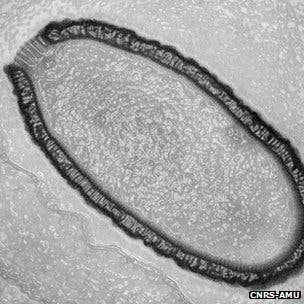It sounds like the synopsis for an apocalyptic movie: scientists uncover a dormant 30,000 years old virus trapped frozen deep in the Siberian permafrost, after it thawed however the researchers were astonished to find the virus was still active and began to infect. The bad news: it’s not a movie plot, this is for real and it was just recently announced to the public. The good news: the ancient virus doesn’t affect humans, just amoebas as far as we can tell for now. The discovery still raises a sum of important questions: what if the virus was indeed capable of infecting humans? How long or what are the actual chances that a given virus can survive for such a long time? Will episodes such as these become common in light of permafrost melting in the Siberian regions and other similar parts of the world as a result of climate change?
Professor Jean-Michel Claverie, from the National Centre of Scientific Research (CNRS) at the University of Aix-Marseille in France, said: “This is the first time we’ve seen a virus that’s still infectious after this length of time.”
The ancient virus was discovered buried deep in ice some 30 m (100 feet) and belongs to a class of giant viruses that were discovered 10 years ago, called Pithovirus sibericum. Like you might imagine, there are a number of peculiarities about it. For one, it’s extremely large; so large that it can be observed via microscope measuring 1.5 micrometres in length. It’s the biggest of its class found so far.

The other peculiar thing about it is that it’s still active after 30,000 years. It hasn’t infected anything since, but as soon as it was taken to a lab, French scientists found it munches on amoebas – single celled organisms.
“It comes into the cell, multiplies and finally kills the cell. It is able to kill the amoeba – but it won’t infect a human cells,” said Dr Chantal Abergel, also from the CNRS.
What if the virus could have affected humans, though? That’s the big question that’s on everybody’s mind. Smallpox for instance, an infectious disease responsible for 300–500 million deaths during the 20th century, has been completely eradicated. Not one single case has been reported in the past few years. What if a new strain of smallpox or some other ancient killer virus that affects human gets dug up next time?
An ancient strain
Since the 1970s, the permafrost has retreated and reduced in thickness, and climate change projections suggest it will decrease further. The local government doesn’t mind much of this, however, and is seeing at as an opportunity to begin exploiting resources. Drilling and digs means that there’s a chance even more viruses such as this might surface.
“It is a recipe for disaster. If you start having industrial explorations, people will start to move around the deep permafrost layers. Through mining and drilling, those old layers will be penetrated and this is where the danger is coming from,” Prof Claverie warns.
Considering that there hasn’t really been a precedent such as this, how common are such ancient virus re-activation events? Was this just a fluke?
“That’s the six million dollar question,” said Professor Jonathan Ball, a virologist from the University of Nottingham, who was commenting on the research.
“Finding a virus still capable of infecting its host after such a long time is still pretty astounding – but just how long other viruses could remain viable in permafrost is anyone’s guess. It will depend a lot on the actual virus. I doubt they are all as robust as this one.”
He added: “We freeze viruses in the laboratory to preserve them for the future. If they have a lipid envelope – like flu or HIV, for example – then they are a bit more fragile, but the viruses with an external protein shell – like foot and mouth and common cold viruses – survive better.
“But it’s the freezing-thawing that poses the problems, because as the ice forms then melts there’s a physical damaging effect. If they do survive this, then they need to find a host to infect and they need to find them pretty fast.”






